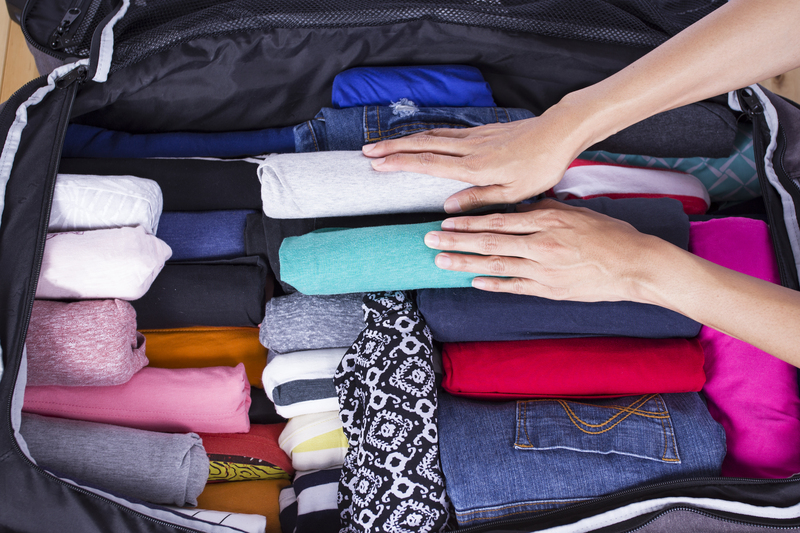Simple Steps to Transport Your Bed and Mattress
Posted on 07/06/2025
Simple Steps to Transport Your Bed and Mattress
Moving homes or rearranging furniture? One of the primary challenges you'll face is how to transport your bed and mattress safely and efficiently. Beds and mattresses are bulky investment pieces, so their safe transfer is crucial. Whether your move is across town or just to another room, understanding the simple steps to transport your bed and mattress can save you stress, money, and time. This comprehensive guide covers practical advice, creative tips, and detailed instructions to help ensure your sleeping set arrives intact and in pristine condition.

Why Is It Important to Move Your Bed and Mattress Properly?
While it's tempting to rush moving large furniture, proper transport of your bed and mattress preserves its comfort, cleanliness, and longevity. Here's why you should follow structured steps:
- Prevents Damage: Mattresses can bend or tear, beds can break or lose parts during careless moves.
- Maintains Hygiene: Beds and mattresses can attract dirt and pests if not protected properly during the move.
- Saves Money: Reduces risk of costly repairs or replacements.
- Ensures Comfort: Proper handling ensures you can continue enjoying restful sleep at your new location.
Step-by-Step Guide to Moving Your Bed and Mattress
Step 1: Gather Necessary Tools and Supplies
A successful move starts with proper preparation. Gather these items before attempting to move your bed and mattress:
- Mattress bag or plastic wrap - Protects the mattress from stains, dust, and moisture.
- Moving blankets - For cushioning and preventing scratches on the bed frame.
- Bubble wrap or padding - For delicate or decorative headboards/footboards.
- Straps or ropes - To secure pieces inside the moving vehicle.
- Basic tools - Such as screwdrivers, Allen keys, and pliers for disassembly.
- Ziplock bags - For storing screws, nuts, and small hardware from your bed frame.
- Marker and tape - To label hardware and bed parts for ease of reassembly.
- Gloves - To protect your hands while lifting heavy items.
Tip: Have a helper or two if possible to make lifting and maneuvering easier and safer!
Step 2: Disassemble the Bed Frame
Most beds can be broken down into smaller, manageable pieces. Here's how to safely disassemble your bed:
- Remove bedding and mattress: Strip all sheets, pillows, and blankets. Set them aside or pack in moving boxes.
- Liftoff the mattress: Ask for help to move your mattress to a safe location where it won't be damaged or soiled.
- Disassemble headboard, footboard, and rails: Use the appropriate tool (usually an Allen wrench or screwdriver). Take photos of the assembly if necessary, which can help during reassembly.
- Detach slats or platform boards: If your bed uses a slat system, gently remove and stack them.
- Organize hardware: Immediately place all screws, bolts, washers, and smaller parts in labeled Ziplock bags. Tape the bags to one of the larger bed parts or keep them all together in a secure place.
- Protect fragile or ornate pieces: Wrap any delicate sections with bubble wrap or moving blankets to avoid scratches or dings during transport.
If your bed is adjustable or has electronic parts (such as a motorized base), consult the manufacturer's instructions before disassembly.
Step 3: Prepare the Mattress for Moving
Your mattress is likely the most expensive and important component. Protect it to ensure a good night's sleep after your move.
- Encase the mattress in a mattress bag or plastic: This keeps dust, bugs, and moisture away. Mattress bags are available at most hardware or moving stores. Ensure all sides are covered and tape the openings securely if necessary.
- Avoid bending or folding: Unless specifically designed to fold (like some foam mattresses), never bend or fold a mattress. This can damage the internal structure and void manufacturer warranties. Always keep the mattress upright or flat.
- Handle with care: Mattresses are heavy and unwieldy. Move them with at least two people, holding from the sides, and avoid dragging them on the floor.
Step 4: Prepare the Bed Frame for Transport
Now that your bed frame is disassembled and hardware is organized:
- Wrap large pieces: Enclose headboards, footboards, and rails with moving blankets or bubble wrap. Secure with packing tape or stretch wrap.
- Label each section: Use marker and painter's tape to label frame pieces for easy assembly at your destination.
- Bundle slats/rails: Tie slats and rails together with straps or stretch wrap to prevent misplacement.
- Protect sharp edges: Cover corners and edges with additional padding to avoid gouges and injuries.
Step 5: Load the Bed and Mattress into the Vehicle
Whether you're using a moving truck, van, or trailer, strategic loading makes all the difference:
- Mattress comes last or stands upright: If there is enough height, stand the mattress on its side; otherwise, it can be laid flat on top of packed boxes and furniture. Avoid placing heavy items on the mattress.
- Secure with straps: Use straps or ropes to keep the mattress and bed parts from shifting during transit.
- Load bed frame parts together: Place all bed pieces near one another to prevent missing parts and ease unpacking.
- Maximize space but don't overcrowd: Give fragile bed pieces space to avoid pressure or damage from heavier items.
Before departure, double check all items are secure and will not move during transportation.
Step 6: Unload and Reassemble at the New Location
The final step is moving the items into your new space and putting your bed back together:
- Choose your bed's new spot before assembly: Plan the layout and clear the space.
- Unwrap and inspect: Check each piece for any damage incurred during transport.
- Follow labels and photos: Use your labels, hardware bags, and any photos you took to help with assembly.
- Reassemble in reverse order: Start with the main frame, adding slats/platform, then attach the headboard, footboard, and finally place the mattress on top.
- Level and check for stability: Ensure every screw is tight and the bed doesn't wobble. If possible, use a level to ensure the bed sits evenly on the floor.
- Add bedding and make your bed: Your bed and mattress have made it through the move in great condition--now, relax and enjoy!
Additional Tips for Hassle-Free Mattress and Bed Transport
1. Measure First, Move Second
Before lifting a finger, measure all doors, stairways, and elevators along the route. Ensure your bed and mattress will fit through these spaces without force. Use a measuring tape for accuracy and plan the best path to minimize hassle.
2. Enlist Help
Beds and mattresses are heavy, awkward to maneuver, and can easily cause injury if lifted incorrectly. Always have at least one helper. For particularly large or heavy beds (such as king size or solid wood frames), several people or professional movers may be necessary.
3. Consider Professional Movers for Oversized or Specialty Beds
Transporting a large or antique bed frame? Consider hiring professionals who are experienced in moving oversized or valuable furniture. They have the expertise, equipment, and insurance coverage to protect your investment.
4. Use a Suitable Vehicle
Rent or borrow a moving van/truck with enough space for both the bed and mattress to lie flat or stand upright, depending on the mattress type. Never force a mattress to bend or cram it into a small car, as this can cause permanent damage.
5. Update or Replace Protection Materials for Long-Distance Moves
If your items will be in storage or in transit for several days, invest in high-quality, waterproof mattress bags and extra padding. Moisture or pests can cause significant damage over time.
*Common Mistakes to Avoid When Moving Beds and Mattresses*
- Dragging mattresses or bed frames: Always lift rather than drag to prevent rips and floor damage.
- Forgetting tools or hardware: Having to search for a missing screw can be frustrating--keep everything organized from the start.
- Stacking items on your mattress: This can leave indentations or destroy internal springs/foam.
- Using insufficient wrapping: Thin plastic may tear easily or fail to protect against sharp objects and moisture.
- Improper loading: Beds and mattresses that are not secured can shift, causing damage to themselves or other items.

Frequently Asked Questions About Bed and Mattress Transportation
1. Can you move a mattress by yourself?
If the mattress is lightweight and you are physically able, you may move a twin or full mattress alone. However, always use proper lifting techniques and avoid carrying large or heavy mattresses without assistance.
2. Is it safe to roll or fold a mattress for transport?
This depends on the type. Some memory foam or boxed mattresses are designed to be folded or rolled--always check the manufacturer's guidelines first. Most innerspring or hybrid mattresses should not be folded as it can damage the structure.
3. What should I do if my mattress gets dirty during the move?
Remove surface dirt with a vacuum or upholstery cleaner. For stains or moisture, follow the manufacturer's care instructions, which often include cleaning with mild soap, letting it air dry completely before use.
4. How long does it take to move and reassemble a bed and mattress?
The process timing depends on the size and complexity of your bed. On average, plan for 1-3 hours, including disassembly, transport, and reassembly.
5. Should I transport my mattress on its side or flat?
Most mattresses are safest when transported on their side to prevent bending or warping. However, check the specific recommendations for your mattress, as some foam models should stay flat.
Summary: Effortless Bed and Mattress Moving
Transporting your bed and mattress doesn't have to be a daunting task. With the right preparation, tools, and a little patience, anyone can manage the process efficiently. Here's a quick recap of the simple steps to transport your bed and mattress:
- Assemble tools and supplies before starting.
- Disassemble the bed frame methodically and keep hardware secure.
- Wrap and protect the mattress and frame components to avoid damage.
- Load strategically and secure all items in the moving vehicle.
- Reassemble and inspect at your destination so you can enjoy a restful night as soon as possible.
Whether you're doing a local move or a long-distance relocation, following these easy steps for moving your bed and mattress will ensure your sleeping setup is protected and ready for the next chapter in your home. Safe moving!





